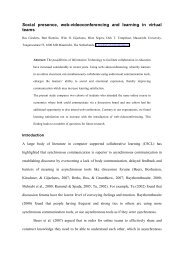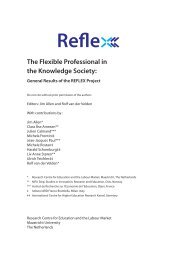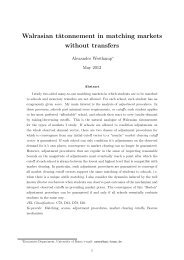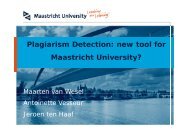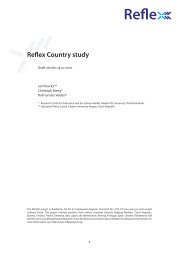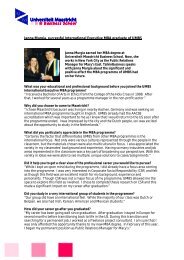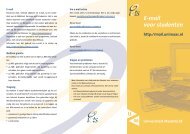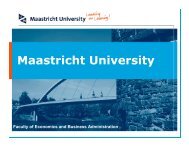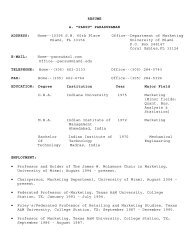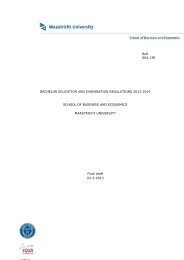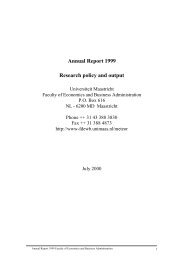proceedings of Student Mobility and ICT: Can E-LEARNING
proceedings of Student Mobility and ICT: Can E-LEARNING
proceedings of Student Mobility and ICT: Can E-LEARNING
Create successful ePaper yourself
Turn your PDF publications into a flip-book with our unique Google optimized e-Paper software.
In order to clarify a need for preparatory courses analysis <strong>of</strong> admission requirements to<br />
undergraduate consecutive university level study programs (Šaunas, 2007) as well as a phenomenon <strong>of</strong><br />
tutorials in education might be useful. Nowadays tutorials are functioning in many countries. In some<br />
countries they have become a huge industry. There are many agencies providing tutorial services in South<br />
Eastern Asian countries. Tutorials are less popular in North America <strong>and</strong> Western Europe but still exist<br />
(Žvirdauskas, 2004). Various aspects <strong>of</strong> tutorials <strong>and</strong> their popularity in Lithuania have been analyzed in<br />
the works by Targamadz, Zabulionis, Zybartas, Želvys (2003), Žvirdauskas (2004), Kvedarien,<br />
Vaiaitien (2004), Bdien, Zabulionis (2006), etc.<br />
Research method. Analysis <strong>of</strong> the scientific literature on the indicators for a need for preparatory<br />
courses. Analysis <strong>of</strong> statistical data on dropout rates after first year <strong>of</strong> studies in Lithuanian universities.<br />
Study <strong>of</strong> various documents on admission requirements to Lithuanian undergraduate consecutive studies in<br />
the context <strong>of</strong> teaching subjects, description <strong>and</strong> analysis <strong>of</strong> research on the most popular study subjects <strong>and</strong><br />
analysis <strong>of</strong> a tutoring phenomenon.<br />
Theoretical approach used<br />
Many higher schools are not succeeding in preparing large numbers <strong>of</strong> young people for lasting<br />
success in further education <strong>and</strong> careers. <strong>Student</strong>s, whose academic skills on entry to university require<br />
considerable remediation, can remedy basic academic skills, potentially limit their potential to graduate.<br />
Generally three indicators <strong>of</strong> a successful participation in higher education are emphasized:<br />
• Attainment <strong>of</strong> academic <strong>and</strong> vocational skills<br />
• Completion <strong>of</strong> a diploma<br />
• Transition <strong>and</strong> retention in higher education <strong>and</strong> the workforce.<br />
According to McMillan at al. (1997), the structure <strong>of</strong> remedial/developmental programs as well as<br />
the philosophical basis on which they are built, are influenced by at least three schools <strong>of</strong> learning theory<br />
(Boylan, 1986): 1) behaviorist theory <strong>of</strong> learning, 2) developmental theory <strong>of</strong> learning, 3) humanistic theory<br />
<strong>of</strong> learning.<br />
Scientific literature review enables us to analyze the following indicators <strong>of</strong> a need for preparatory<br />
courses: 1) lack <strong>of</strong> academic performance; 2) lack <strong>of</strong> pr<strong>of</strong>essional motivation (Deci <strong>and</strong> Ryan (1987) point<br />
out that the feelings <strong>of</strong> competence <strong>and</strong> self-determination are two fundamental components <strong>of</strong> intrinsic<br />
motivation, other researchers claim that if school administrators, teachers <strong>and</strong> parents are supportive <strong>of</strong><br />
students’ autonomy, they feel competent in school activities <strong>and</strong> self-determinant in school-related affairs.<br />
Autonomy <strong>and</strong> competence perceived by students further develop into self-determined school motivation);<br />
3) lack <strong>of</strong> career counseling (Some research indicates that career intervention should be occur through a<br />
holistic philosophy (Lee, Johnston, 2001). Betz (2006) holds that successful career intervention is such that<br />
is based on the sources <strong>of</strong> self-efficacy (B<strong>and</strong>ura, 1997): mastery experience, vicarious experience, social<br />
persuasion <strong>and</strong> physiological state; 4) differences in learning cultures if they leave secondary school; 5)<br />
differences in national cultures if they go abroad; 6) differences in a social status if there is a change in<br />
family support. All the above mentioned indicators lead to the reduction <strong>of</strong> drop-out rates in higher<br />
education. The rate <strong>of</strong> drop-out <strong>of</strong> a higher institution is a complicated problem related to such<br />
environmental factors as characteristics <strong>of</strong> the school, family <strong>and</strong> community as well as personal attributes<br />
<strong>of</strong> drop-out students, their low motivation (Csikszentmihalyi, Nakamura, 1989; Deci, Ryan’s, 1987;<br />
Lepper, Hodell, 1989), poor academic performance (Astone, McLanahan, 1991; Ensminger, Slusarcick,<br />
1992; Fetler, 1989; Jordan et al., 1996; Kaplan et al., 1997; Marsh, 1991; Morris, Ehren, Lenz, 1991;<br />
Roderick, 1994; Simner, Barnes, 1991). A high drop-out rate is a major educational problem for drop-out<br />
students <strong>and</strong> society. Technological advancement has placed a dem<strong>and</strong> for a highly educated work force<br />
<strong>and</strong> decreased dem<strong>and</strong> for unskilled labor. Several theoretical models have been developed to explain the<br />
influences that affect students’ decision to complete their studies in higher education. In Tinto’s model<br />
retention is influenced by a student's pre-entry attributes, goals <strong>and</strong> commitments, <strong>and</strong> academic <strong>and</strong> social<br />
integration (Tinto, 1975). Bean (1985) has developed a model conceptualizing a student’s persistence as<br />
Conference <strong>proceedings</strong> <strong>of</strong> <strong>Student</strong> <strong>Mobility</strong> <strong>and</strong> <strong>ICT</strong>: <strong>Can</strong> E-<strong>LEARNING</strong> overcome barriers <strong>of</strong> Life-Long learning?” 86




